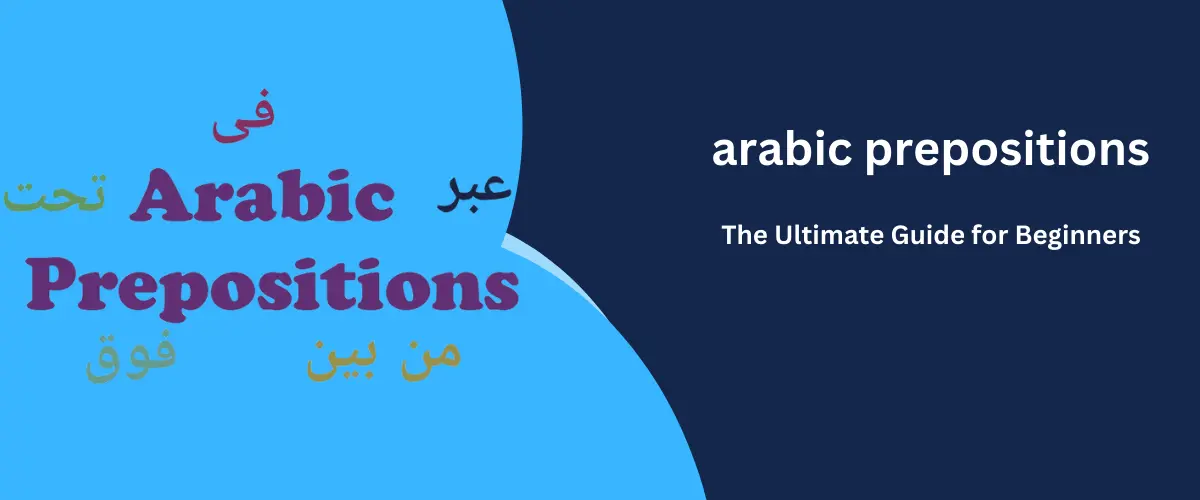The Arabic language is one of the richest and most fascinating languages. Its unique grammatical rules make it challenging for beginners to learn.
In this article, we will explore one of the most important topics of Arabic grammar, which is the Arabic prepositions, their definition, importance, usage, and common mistakes to avoid while using them.
What are Arabic prepositions?
Arab grammarians have not agreed on a precise definition of prepositions, which are considered a subcategory of particles (الحروف).
Particles are words that have a linking function with other parts of speech but do not have a meaning in themselves.
However, an Arabic preposition (حَرْفُ الْجَرِّ- Harfu al-jarri) can be defined as a single letter or a single word that is used to connect two nouns or a verb and a noun to form a complete sentence.
How to pronounce prepositions in Arabic?
If you’re wondering how to pronounce prepositions in Arabic, they’re referred to in the Arabic language as “huroof al-jarr – حروف الجر”.
How do prepositions function in Arabic sentences?
In Arabic grammar, prepositions ( or حروف الجر ) act as connectors between a noun and the other elements of a sentence. Their primary function is to provide information about time, place, and direction.
What are all the prepositions in Arabic and their English translation?
There are around 20 prepositions in the Arabic language. These prepositions are classified into detached (separable) and attached (nonseparable) prepositions.
From the Ajrumiyyah:
وَهَِيِ مْن وَإلى وَعَْن وَعَلَى وَفِْي وَُرّب وَالْباءُ وَالْكَاُف وَالّلاُم وَُحُروُْف الَْقْسمِ، وَهَِي الْواوُ وَالْباءُ وَالتّاء
What are the detached Arabic prepositions?
A detached Arabic preposition stands alone and is written separately from the noun following it. The table below shows some examples of detached Arabic prepositions:
| Arabic preposition | Meaning in English |
| في | in, at, with |
| عدا | except |
| عن | about, on behalf of, away from |
| حتى | up to, to, at |
| من | from, of, than |
| إلى | to, till |
| على | on |
| منذ – مذ | since |
Read More: THE COMPREHENSIVE GUIDE TO ARABIC CONNECTING LETTERS
What are the attached Arabic prepositions?
The attached prepositions are made up of one letter and are always linked to the word following them. Examples of attached Arabic prepositions are:
| Arabic preposition | Meaning in English |
| ك | like, similar to |
| ل | to, for |
| ب | with, by, in |
| ت | used to make oaths |
| و | used to make oaths |
| بِ | used to make oaths |
Other Classification of Arabic Prepositions
Arabic prepositions can also be classified according to the meaning they add to the sentence into three types: true prepositions, redundant prepositions, and quasi-redundant prepositions.
- True prepositions ( حروف الجر الأصلية) add meaning to the sentence in which they appear, cannot be preceded by other prepositions, and can combine with a verb to create a verb-preposition idiom.
- Redundant prepositions ( حروف الجر الزائدة ) do not add any new meaning and are used for emphasis.
- Quasi-redundant prepositions ( حروف الجر شبه الزائدة ) add a limited meaning, such as “perhaps – رُب”
How are prepositions used in Arabic?
Prepositions are either a single letter or a word that links two nouns or a noun and a verb to create a sentence.
In Arabic, a preposition always comes before the word it’s associated with and never follows it. For example:
- ذهب علي إلى المدرسة
- Ali went to school.
- عاد خالد من العمل
- Khaled came from work.
The unique characteristics of Arabic prepositions
Now let’s discuss some of the unique characteristics of Arabic prepositions.
- The meaning of Arabic preposition depends on its place in the sentence; in other words, the Arabic preposition may be used to indicate different meanings according to the words that come before and after it.
- Arabic preposition particles are considered Mabni words كلمات مبنية, meaning they typically possess the same pronunciation regardless of their location in the sentence.
Differences between Arabic prepositions and locative adverbs
Locative adverbs, also known as adverbs of place and time (ظرف المكان وظرف الزمان), share similarities with prepositions as they always require a genitive noun. They are sometimes referred to as semi-prepositions.
Examples of common locative adverbs include “with” (مَع), “at” (عَنْد), and “between” (بَيْن). Locative adverbs are derived from trilateral lexical roots and are grammatically considered a type of noun.
The genitive noun that follows them is considered part of an iḍafa construction, such as “at the house” (عَنْد البَيْت) and “with my friends” (مَع أَصْدِقَائِي).
What do we call the noun that follows a preposition in Arabic?
In Arabic grammar, this noun is referred to as “majroor مجرور”. It is in the genitive case (jarr جرّ). When a noun comes after a preposition, it will end in either “kasrah” or “tanween kasra” depending on whether it is definite or not.
However, for dual or sound masculine plural nouns, the change occurs in the second-to-last letter, which becomes a ي, while the final vowel remains the same. As a result, they end in يْنِ if they are dual, definite or not, and ينَ if they are sound masculine plural, definite or not.
Common Mistakes in Using Arabic Prepositions
Prepositions pose a challenge for Arabic learners who struggle to choose and use them correctly. Here is what makes learning Arabic prepositions daunting for non-Arabs:
- Preposition usage can be highly idiomatic and may not correspond to their English equivalents. As a result, learners of Arabic make errors and need guidance on preposition use and related structures.
- Both Arabic and English have prepositions with multiple meanings that change based on the sentence’s context.
- Certain prepositions are fixed expressions used with specific nouns, verbs, and adjectives.
- One difference between Arabic and English is that a preposition might be necessary in Arabic but not in English and vice versa.
- Additionally, prepositions in English may differ significantly from Arabic in meaning and usage, so direct equivalence should not be assumed.
learn more: YOUR COMPLETE GUIDE TO ARABIC VERB CONJUGATION
Understanding Arabic prepositions used in time expressions
Prepositions of time indicate the exact time an event or action took place. In the Arabic language, several prepositions are used to convey different time frames. The following are some of the most commonly used prepositions of time in Arabic and their usage.
Preposition “في” (at-in)
The preposition “في” (fi) is utilized to signify a specific time or period of occurrence. It commonly indicates the time of the day or a day of the week. For instance:
- في الصباح (fī al-ṣabāḥ) = “in the morning”
- في نهاية الأسبوع (fī nihāyat al-ʾusbūʿ) = “at the end of the week”
- في اللحظة (fī al-laḥẓah) = “at the moment”
Preposition “منذ” (since)
The preposition “منذ” (mundhu) is utilized to indicate the duration of an event or action since a specific time or occurrence. It is commonly paired with time expressions, such as:
- منذ سنة (mundhu sana) – since a year
- منذ يوم (mundhu yawm) – since a day
- منذ أسبوع (mundhu usbu’) – since a week
Preposition “حتى” (until)
The preposition “حتى” (hata) is used to indicate the end of a certain event or time. It works with both specific and general time references. Examples include:
- حتى الصباح (hata al-sabah) – until morning
- حتى الظهر (hata al-dhuhr) – until noon
- حتى المساء (hata al-masa) – until evening
Prepositions for indicating location and direction
Prepositions of place describe the location of an event or action. Arabic has various commonly used prepositions of place, similar to prepositions of time.
Use of Arabic prepositions in locative phrases with examples
Below are some of the most frequently used prepositions of place and their usage:
Preposition “في” (at-in):
The word “في” (fi) is a preposition that signifies the location of an event or action. It is commonly used to indicate the location of a building, city, or country. For example:
- في البيت (fi al-bayt) – at home
- في المدرسة (fi al-madrasa) – at school
Preposition “علي” (upon- on):
The preposition “على” (ala) is utilized to show the location of an object or the surface on which an action occurs. It signifies that an action or event is taking place on or upon something. Some examples of its usage include:
- على المنضدة (ala al-mindada) – on the table
- على الأرض (ala al-ard) – on the ground
- على الجبل (ala al-jabal) – on the mountain
Arabic Prepositions for indicating abstract relationships
Arabic, like other languages, uses prepositions to indicate relationships between words in a sentence. However, Arabic prepositions can also indicate more abstract relationships, such as possession, association, and causality. Some common prepositions used for these purposes include:
Preposition “مِن” – “min” (from/of)
The preposition “min” is used to express the source of something, such as “I received a gift from my friend” which would be “Istalamtu hadiya min sadeeqi” “استلمت هدية من صديقي” in Arabic.
preposition “بِ” – “bi” (by/with)
The preposition “bi”- “بِ” is used to express the instrument of an action, such as “I wrote with a pen” which would be “ktabt bi al-qlam” “كتبت بالقلم” in Arabic.
How to construct prepositional phrases in Arabic?
Prepositional phrases are a group of words that begin with a preposition and end with a noun or pronoun. Essentially, they describe the relationship between the noun or pronoun and other words in a sentence.
The preposition itself indicates the relationship, such as location, direction, time, or manner. Prepositional phrases can also add detail and specificity to sentences, making them more descriptive and informative.
What are the examples of Arabic prepositional phrases?
Examples of prepositional phrases in Arabic include:
- “fawqa ra’see”, “فوق رأسي” meaning “above my head”.
- “ba’dal-‘ashaa’i”, “بعد العشاء” meaning “after dinner”.
- “khalfash-shajarati”, “خلف الشجرة” meaning “behind the tree”.
- and “amaamas-sayyaarati”, “أمام السيارة” meaning “in front of the car.”
Bottom line
Prepositions play a crucial role in both Arabic writing and speech structure. They serve as fundamental elements in constructing sentences and contribute significantly to their coherence.
As a beginner, you may find it challenging to master the use of Arabic prepositions as they widely differ from other languages.
No need to worry! Kalimah Online Arabic Teaching Academy is here to help you learn Arabic grammar in the easiest and most efficient way.
Begin your journey towards mastering the Arabic language by joining Kalimah Arabic language classes today!
Test Your Knowledge!
Now that you have learned everything about Arabic prepositions. Test your knowledge by sorting out Arabic prepositions from this random page of the Quran.
Answer:
- بزعمهم
- عليها
- عليه
- بما
- في بطون
- فيه
- بغير
- على الله
- من ثمره
- ومن الأنعام
- مما رزقكم
🌟 Unlock Your Potential in Arabic with Kalimah Center! 🌟
Ready to deepen your connection with the Quran and enhance your understanding of Arabic? Join Kalimah Center today and embark on a transformative journey of learning and growth! Our professional, handpicked Online Arabic and Quran Tutors are dedicated to helping you master these essential skills with ease and expertise.
📚 Explore Our Courses:
Online Arabic Course: Tailored to your level, our comprehensive Arabic program includes 16 teaching levels and 400+ hours of personalized sessions.
Online Arabic Course For Kids: Nurture your child’s love for Arabic with our engaging and structured program, available in 24 levels for primary, intermediate, and secondary stages.
💡 Why Choose Kalimah?
Expert Tutors: Learn from native Arabic speakers and Ijazah-certified teachers who prioritize your progress.
Flexible Learning: Enjoy one-on-one classes, 24/7 access to materials, and interactive exercises for a dynamic learning experience.
Comfortable Environment: Benefit from a supportive and encouraging atmosphere, where mistakes are seen as opportunities for growth.
Proven Success: With over 8,000 students worldwide and glowing testimonials, Kalimah Center is your trusted partner in Arabic and Quran education.
🚀 Start Your Free Trial Today! 🚀
Don’t miss out on this life-changing opportunity to deepen your faith and knowledge. Sign up now for your free trial and take the first step towards becoming a better practicing Muslim with Kalimah Center!
FAQs
Can one Arabic preposition have multiple meanings?
Yes, Several English prepositions can be represented by a single Arabic preposition. It may seem that each Arabic preposition has a singular meaning and usage. However, this is not the case.
For example, the letter ب (baa) can signify numerous things, including ‘with’ and ‘by’. The meaning of the Arabic preposition depends on its place in the sentence and what comes before and after the preposition.
How do prepositions affect the case of the following nouns in Arabic?
The nouns following Arabic prepositions change from nominative case (dammah– Marfou’) to genitive case (Kasrah- Majrour).
How do you tell if a word is a preposition?
A preposition is a “Harf” or “particle” that adds meaning to the word following it, in addition to changing the case of the noun following it from nominative to genitive case.
Does Arabic have prepositions or postpositions?
Yes, Postpositions are sometimes used in Arabic after a noun or pronoun to provide additional information about their location, direction or relationship to other elements in the sentence. For instance:
- أنا ذاهب إلى المدرسة بعد الظهر. (I am going to school this afternoon.)
- سألت عن الكتاب من دونهِ. (I asked about the book without him.)
- تحدثتُ معهُ في مكتبهِ. (I spoke with him in his office.)
- هذا المنزل خلف المسجد. (This house is behind the mosque.)
- لقد رأيتُهُ في الشارعِ قبل الفجرِ. (I saw him in the street before dawn.)
What are some of the most common mistakes non-native speakers make with Arabic prepositions?
One of the most common mistakes non-native speakers make with Arabic prepositions is using them incorrectly or inconsistently. For example, confusing the prepositions “fi” and “bi” which both can mean “in” but are used in different contexts. Additionally, some prepositions have multiple meanings and can be used in different ways depending on the context, leading to confusion for non-native speakers.
What is Harf al Jarr in Arabic?
Harf Al Jarr is the Arabic word for “preposition”, it denotes the word or phrase connecting nouns to other parts of the sentence.















